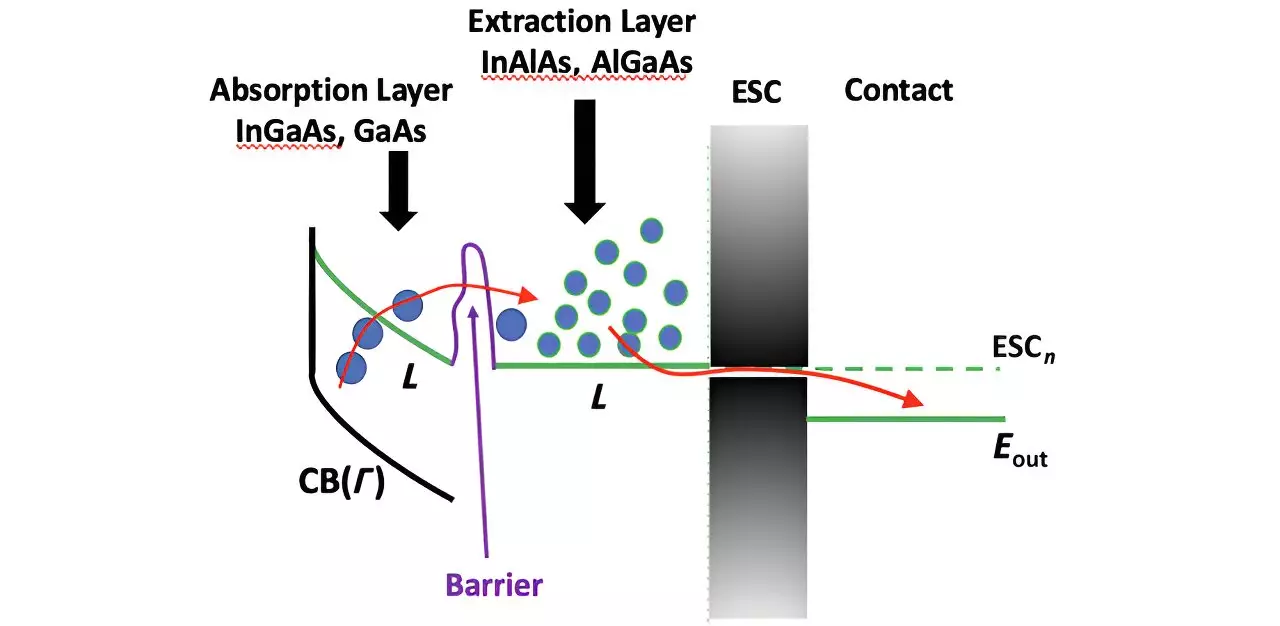Hot carrier solar cells represent an innovative advancement in the quest for enhanced efficiency in solar energy conversion. Introduced several decades ago, these cells offer hope to transcend the Shockley-Queisser efficiency limit — the maximum expected efficiency for conventional single-junction solar cells. By capitalizing on the energy of “hot” electrons, which possess more energy than their cooler counterparts, hot carrier technology aims to leverage excess energy without it being lost as heat. However, realizing this potential has proven an arduous journey, with significant technical barriers to efficient electron extraction haunting researchers to this day.
The extraction of hot electrons, which must occur rapidly to prevent energy loss, has been a pivotal point of contention in the deployment of hot carrier solar cells. One promising strategy has been the employment of satellite valleys in the conduction band, which can temporarily store these high-energy electrons before they are collected. Despite the theoretical promise behind this strategy, practical implementations have exposed the existence of parasitic barriers at the heterostructure interface between the materials involved. More specifically, mismatches in energy band alignment complicate this transfer, necessitating a deeper understanding of how electrons navigate through these challenging interfaces.
Experimental observations have shed light on a critical aspect of this issue: when electron energies are not precisely matched between two materials at the interface, tunneling—an alternative pathway that electrons can leverage—becomes a key player. The intricacies of band structures influence this process significantly. Recent studies have employed advanced techniques like the empirical pseudopotential method to discern the behaviors of electrons at these boundaries, especially focusing on evanescent states and their role in facilitating or inhibiting tunneling.
In a pivotal study detailed in the Journal of Photonics for Energy, researchers investigated electron tunneling in structures comprised of indium-aluminum-arsenide (InAlAs) and indium-gallium-arsenide (InGaAs). Their work revealed that the tunneling coefficient—indicative of the ability of electrons to pass through the barrier—is significantly influenced by the mismatch in energy bands between these materials. Intriguingly, electron transfer is severely impeded even by minimal roughness at the material interface, demonstrating a clear correlation between interface quality and device performance.
Further complicating the situation is the nuanced relationship between electron mobility and tunneling dynamics. When the energy bands are poorly aligned, electron transfer can plummet, leading to poor performance in experimental hot carrier solar cells. This corroborates the findings that have plagued the indium-based materials. However, the research also illuminated favorable conditions found in the AlGaAs/GaAs material system, where better energy alignment and atomic precision in growth allow for enhanced electron transfer capabilities.
The research findings indicate markedly improved tunneling coefficients within AlGaAs and GaAs, which can reach values as high as 0.88, dependent on the aluminum composition used. Such efficient tunneling heralds a promising pathway for the development of valley photovoltaics, which could break free from the frustrating constraints imposed by single bandgap limitations.
Through methods such as real-space transfer, where hot carriers can transition from GaAs back to AlGaAs with ease, a potential duality emerges—what may be considered undesirable behavior in transistors may provide groundbreaking advantages in valley photovoltaics. Herein lies a paradigm shift in how researchers might view electron behavior across different materials, now considering the potential for optimizing mobility and transfer efficiency as a pathway to higher solar cell efficiencies.
The journey of developing hot carrier solar cells has been rife with challenges; however, recent research illuminates pathways that may eventually lead to viable implementations. As scientists continue to unravel the complex interactions at material interfaces, particularly through the lens of tunneling dynamics, the vision of advanced solar cells that far exceed existing efficiency limits comes ever closer. As we forge ahead in exploring hot carrier dynamics, it becomes evident that the materials we choose and the structural precision we achieve will play a crucial role in realizing the full potential of this innovative technology.


Leave a Reply